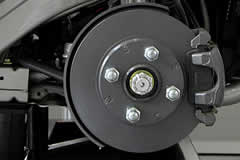What Do I Do When My Brakes Have Stopped Working? - Vol.212
The average lifespan of brake pads is anywhere from 50-110,000km (30-70,000 miles) before they require replacement. This number varies largely due to the fact that rear wheel drive and front wheel drive cars will wear down their tire sets at different rates. Some common symptoms that your breaks need replacement include:
- Pulling to one side or the other
- Grinding noises when you hit the break
- Vibrating
- Noticeable decreases in stopping distance

Vehicles experiencing any of these symptoms should be taken in for a break inspection and/or replacement if necessary. Continuing to ignore break problems and driving on roadways can cause serious danger to yourself and others on the road. If for any reason your breaks do go out while driving, follow these safety tips to reduce the chance of injury to yourself or your occupants.
1. Remove cruise control if you have it switched on and take your foot completely off the gas to allow your car to decelerate. Do not panic or make any sudden movements with the steering wheel. Always keep your eyes on the road and continue steering to avoid oncoming traffic or obstacles. Use your horn and hazard lights to alert other drivers on the road that you are experiencing an emergency and that they should get out of the way if possible.
2. Start by pumping the breaks with your foot. If you can't push down the break, check to see if something is lodged underneath the brake pedal that is preventing the pedal from moving. Continuous pumping action should build up hydraulic pressure in the break system, allowing you to stop the car or at least help to slow it down.
3. Shift your car into the lowest gear possible to reduce the energy being produced by the engine. Even automatic cars can be shifted to a lower gear by looking for the '1' on the shifter used to put your car in drive. Then move your way into the furthest right line out of the main flow of traffic.
4. Slowly apply the emergency break so that the back wheels are able to come to a stop gradually and you don't risk losing control of the vehicle.
5. Once you start to slow down to a controlled level, carefully move your vehicle back and forth in the lane or in surrounding lanes if there are no cars in the area. This will help to naturally slow your vehicle and reduce your speed even further.
6. Pay attention to your surrounding area. If you are going down a slope or hill, look out for ramps there were designed for runaway trucks and vehicles and head into it. Otherwise, look for possible areas that would be safe to crash if you have no other option. Aim your car up a hill, or into a side pull off area that is free of pedestrians and will cause the least damage to your car and its occupants. Large structures such as trees, buildings, or metal objects of any kind should be avoided.
7. If the crash is inevitable and you have someone else in the car with you, have that person call the emergency line inform the responders of your situation so that they can send help right away. Do not attempt to use your phone if you are alone and trying to bring your car to a step, this will only increase the severity of your current predicament. When you do crash, call for help immediately. If you aren't hurt exit the vehicle and get away from the flow of traffic so that you are in a safe location to wait for help to arrive.